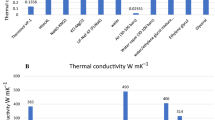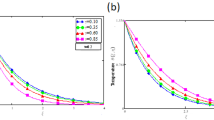Abstract
This article aims to enhance the efficiency of Diffusion Absorption Refrigeration (DAR) systems which operate at low efficiency. This study experimentally investigates the effect of passive heat transfer enhancement by using various nanofluids as working fluids including ammonia/water couple with different rates of magnesium oxide aluminate spinel (MgOAl2O3) particles. The tests have been carried at the same ambient conditions to obtain reliable results. Additionally, nanofluid has been prepared and tested in two different particle concentration (1% and 2%). Adding nanoparticles to the base fluid (25% ammonia/water) can make an important positive effect in increasing heat transfer by extending surface area and heat capacity of the fluid. Experimental results showed that using nanofluid as working fluid in DAR system results in faster evaporation which decreases operation time and increases heat transfer in generator. Moreover, the DAR system containing 2% concentration of nanofluid solution led to a 37.4% increase in performance coefficient (COP) and a 44.2% increase in exergetic performance coefficient (ECOP) compared to the DAR system without nano particles.













Similar content being viewed by others
Abbreviations
- Cp :
-
specific heat capacity (J kg−1 K−1)
- h :
-
specific enthalpy (kJ kg−1)
- \( \dot{m} \) :
-
mass flow rate (kgs−1)
- p:
-
pressure (bar)
- q h :
-
power of generator (W)
- q rf :
-
heat transported from rectifier (W)
- \( \dot{\mathrm{Q}} \) :
-
heat exchanged (W)
- T:
-
temperature (°C)
- WR :
-
total uncertainty (%)
- w1, w2, wn :
-
uncertainties in the independent variables
- x :
-
mass fraction of the solution (−)
- \( \mathsf{evap} \) :
-
Evaporator
- \( \mathsf{h} \) :
-
Heater
- \( \mathrm{g}-\mathrm{v} \) :
-
generator-vapor
- g − w:
-
generator-water (water by weak solution)
- \( \mathsf{o} \) :
-
ambient
- \( \mathsf{rf} \) :
-
Rectifier
- rf − w:
-
rectifier-water (water by solution)
- \( \mathsf{rf}-\mathsf{v} \) :
-
rectifier-vapor
- 1, 2, 4a…:
-
system’s point designation.
- \( \mathsf{CFCs} \) :
-
Chlorofluorocarbons
- COP:
-
Coefficient of Performance
- DAR:
-
Diffusion Absorption Refrigeration
- \( \mathsf{DMAC} \) :
-
Dimethylacetamide
- ECOP:
-
Exergetic Coefficient of Performance
- HCFCs:
-
Hydro Chloro Fluoro Carbons
- \( \mathsf{He} \) :
-
Helium
- MgOAl2O3 :
-
Magnesium oxide aluminate spinel
- SDBS:
-
Sodium Dodecyl Benzene Sulfonate
- SHE:
-
Solution Heat Exchanger
References
Von Platen BC, Munters CG (1928) Refrigerator. US Patent 1:685–764
Pérez-García V, Rodríguez-Muñoz JL, Belman-Flores JM, Rubio-Maya C, Ramírez-Minguela JJ (2019) Theoretical modeling and experimental validation of a small capacity diffusion-absorption refrigerator. Int J Refrig 104:302–310
Chaves FD, Moreira MFS, Koury RN, Machado L, Cortez MFB (2019) Experimental study and modeling within validation of a diffusion absorption refrigerator. Int J Refrig 101:136–147
Hassan HZ, Mohamad AA (2012) A review on solar cold production through absorption technology. Renew Sust Energ Rev 16:5331–5348
Gutierrez F (1998) Behaviour of a household absorbtion-diffusion refrigator adapted the autonomous solar operation. Sol Energy 40:17–23
Rattner AS, Garimella S (2016a) Low-source-temperature diffusion absorption refrigeration. Part I: Modeling and cycle analysis. Int J Refrigeration 65:287–311
Rattner AS, Garimella S (2016b) Low-source-temperature diffusion absorption refrigeration. Part II: Experiments and model assessment. Int J Refrigeration 65:312–329
Sözen A, Özbaş E, Menlik T, Çakır MT, Gürü M, Boran K (2014) Improving the thermal performance of diffusion absorption refrigeration system with alumina nanofluids: an experimental study. Int J Refrig 44:73–80
Chen J, Kim JK, Herold KE (1996) Performance enhancement of a diffusion absorption refrigerator. Int J Refrig 19:208–218
Zohar A, Jelinek M, Levy A, Borde I (2008) The influence of the generator and bubble pump configuration on the performance of diffusion absorption refrigeration (DAR) system. Int J Refrig 31:962–969
Zohar A, Jelinek M, Levy A, Borde I (2007) The influence of diffusion absorption refrigeration cycle configuration on the performance. Appl Therm Eng 27:2213–2219
Srikhirin P, Aphornratana S (2002) Investigation of a diffusion absorption refrigeration. Appl Therm Eng 22:1181–1193
Starece G, De Pascalis L (2012) An advanced analytical model of the diffusion absorption refrigation cycle. Int J Refrig 32:605–612
Starace G, De Pascalis L (2013) An enhanced model for the design of diffusion absorption refrigerators. Int J Refrig 36:1495–1503
Belman-Flores JM, Rodríguez-Muñoz JL, Rubio-Maya C, Ramírez-Minguela JJ, Pérez-García V (2014) Energetic analysis of a diffusion–absorption system: a bubble pump under geometrical and operational conditions effects. Appl Therm Eng 71:1–10
Wang SK, Wang J, Wang Q, Wang YL, Chen GM (2017) Experimental research on the performance of the diffusion absorption refrigerator with mixed fluoride refrigerants. Int J Refrig 81:50–59
Acuña A, Velazquez N, Cerezo J (2013) Energy analysis of a diffusion absorption cooling system using lithiumnitrate, sodiumthiocyanate and water as absorbent substance and ammonia as the refrigerant. Appl Therm Eng 51:1273–1281
Zohar A, Jelinek M, Levy A, Borde I (2009) Performance of diffusion absorption refrigeration cycle with organic working fluids. Int J Refrig 32:1241–1246
Mansouri R, Borouis M, Bellagi A (2017) Experimental investigations and modelling of a small capacity diffusion-absorption refrigerator in dynamic mode. Appl Therm Eng 113:653–662
Mansouri R, Borouis M, Bellagi A (2018) Steady state investigations of a commercial diffusion-absorption refrigerator: experimental study and numerical simulations. Appl Therm Eng 129:725–734
Khan I, Saeed K, Khan I (2019) Nanoparticles: properties, applications and toxicities. Arab J Chem 12:908–931
Gürü M, Sözen A, Karakaya U, Çiftçi E (2019) Influences of bentonite – deionized water nanofluid utilization at different concentrations on heat pipe performance: an experimental study. Appl Therm Eng 148:632–640
Khanlari A, Sözen A, Variyenli Hİ (2019a) Simulation and experimental analysis ofheat transfer characteristics in the plate type heat exchangers using TiO2/waternanofluid. Int J Numerical Methods Heat & Fluid Flow 29:1343–1362
Sanukrishna SS, Murukan M, Prakash MJ (2018) An overview of experimental studies on nanorefrigerants: recent research, development and applications. Int J Refrigeration 88:552–577. https://doi.org/10.1016/j.ijrefrig.2018.03.013
Khanlari A, Sözen A, Variyenli Hİ, Gürü M (2019b) Comparison between heat transfer characteristics of TiO2/deionized water and kaolin/deionized water nanofluids in the plate heat exchanger. Heat Transfer Res 50:435–450
Khanlari A, Yılmaz Aydın D, Sözen A, Gürü M, Variyenli Hİ (2020) Investigation of the influences of kaolin-deionized water nanofluid on the thermal behavior of concentric type heat exchanger. Heat Mass Transf. https://doi.org/10.1007/s00231-019-02764-1
Aman J, Henshaw P, Ting DS-K (2018) Performance characterization of a bubble pump for vapor absorption refrigeration systems. Int J Refrig 85:58–69
Jemaa RB, Mansouri R, Bellagi A (2016) Dynamic testing and modeling of a diffusion absorption refrigeration system. Int J Refrig 67:249–258
Wu W, Wu J, Wang Y, Zhang H (2017) The enhancing influence of nanoparticles on ammonia/water falling film absorption in binary nanofluids under pressure reducing conditions. J Thermal Sci Technol 12:JTST0018
Yang L, Du K, Bao S, Wu Y (2012) Investigations of selection of nanofluid applied to the ammonia absorption refrigeration system. Int J Refrig 35:2248–2260
Jiang W, Li S, Yang L, Du K (2019) Experimental investigation on performance of ammonia absorption refrigeration system with TiO2 nanofluid. Int J Refrig 98:80–88
Amaris C, Bourouis M, Vallès M (2014) Passive intensification of the ammonia absorption process with NH3/LiNO3 using carbon nanotubes and advanced surfaces in a tubular bubble absorber. Energy 68:519–528
Kline SJ, McClintock FA (1953) Describing uncertainties in single-sample experiments. Mech Eng 75:3–8
Nanografi Nanotechnology AS.: https://nanografi.com/
Author information
Authors and Affiliations
Corresponding author
Additional information
Publisher’s note
Springer Nature remains neutral with regard to jurisdictional claims in published maps and institutional affiliations.
Rights and permissions
About this article
Cite this article
Sözen, A., Keçebaş, A. & Gürbüz, E.Y. Enhancing the thermal performance of diffusion absorption refrigeration system by using magnesium aluminate spinel oxide compound nanoparticles: an experimental investigation. Heat Mass Transfer 57, 1583–1592 (2021). https://doi.org/10.1007/s00231-021-03046-5
Received:
Accepted:
Published:
Issue Date:
DOI: https://doi.org/10.1007/s00231-021-03046-5




